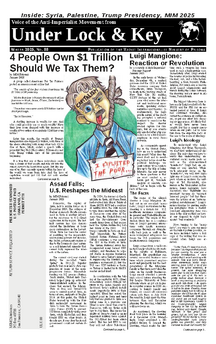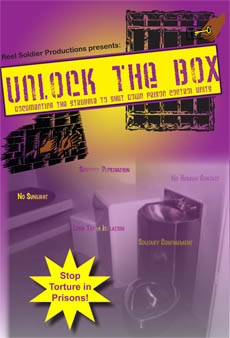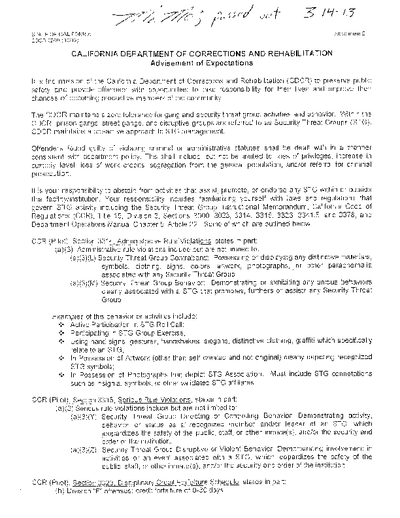
San Quentin Adjustment Center list of demands to CDCR
Open letter to the Director of CDCR, the Warden of San Quentin Prison and the Captain of the Adjustment Center
San Quentin top officials have concocted and enacted an exclusive code of regulations called the IP 608 Condemned Manual, which mandates that Death Row prisoners are under the control of the warden of San Quentin Prison. Therefore, after years of the abuse of authority by Adjustment Center (A/C) committee members and unit staff and after years of filing 602s that fall on deaf ears here in the A/C, all the way up the chain of command to Sacramento, a collective group of Death Row prisoners in the A/C will be joining in the statewide non-violent, peaceful hunger strike in July 2013 to demand that the warden of San Quentin use his power of authority to bring about positive change to prisoners housed in the A/C SHU.
For years, Grade B A/C prisoners have been told Grade B is not a punishment; it’s just a “program” different from Grade A. So the warden should be able to use his power of authority to order the following immediate changes without delay:
-
The warden should immediately implement a “behavior based program” that
amends the current criteria that permit a condemned prisoner to be
eligible for Grade A privileges and be removed from the punitive
punishment of Grade B status, basing this program on a condemned
prisoner’s current good behavior and disciplinary free conduct
regardless of a prisoner’s alleged gang status or validation and
eliminating the under-the-table and vague indeterminate status in the
A/C. The warden must order the immediate release of A/C prisoners who
are not validated as alleged gang members and associates and have
remained disciplinary free for years.
-
The warden must order the A/C committee to stop the controversial and
unfair classification practices of using illegal inmate informants and
anonymous informants and the so-called roster list of names to label
prisoners gang members and associates and to stop the illegal and vague
“mandatory debriefing” and vague validation process. San Quentin
officials must put in place a set of standards and safeguards to protect
a prisoner’s right to be free from cruel and unusual punishment
-
Any information used in A/C committee decisions must be first-hand
information and must be corroborated by three different independent
sources;
-
A/C committee must state on the record why such information is
indicative of gang activity and state on the record what California laws
are being broken;
-
Any information used against a prisoner must be provided to the prisoner
and all copies of documents, such as 1030s and 128s, and debriefing
reports placed in a prisoner’s C-file must be immediately disclosed to
the prisoner so he will have ample time and opportunity to contest and
challenge any allegations in writing through administrative 602s and
legal redress to confront his accuser or confidential source.
-
Any information used in A/C committee decisions must be first-hand
information and must be corroborated by three different independent
sources;
-
The warden must (a) order the end of the administrative segregation of
condemned prisoners to segregated yards that have been designed to label
a condemned prisoner unjustly, (b) order an end to the constant use of
bogus confidential inmate informants and bogus 1030 disclosure forms to
deny A/C prisoners access to Grade A status and access to the A/C group
yards, and (c) order that all four group yards in the A/C be labeled
“re-integrated yard 1, 2, 3 and 4” and remove the racist yard labels of
“Southern/White and Northern/Black” that A/C staff and committee have
used for decades to instigate racial division and segregation among
prisoners of different races who would like to program and co-exist on a
group yard together. Every A/C prisoner should be given group yard
unless the prisoner chooses to stay in a walk-alone cage. The warden
must order that all walk-alone cages have roof coverings like the cages
in East Block and Carson Sections, and add a dip bar in each cage for
exercise.
-
The warden should cease all group punishment tactics. Group punishments
and lockdowns were designed for large-scale riots, not for alleged
isolated incidents. The warden should cease the unlawful use of the
interview/interrogation process and never allow the vicious attack and
assault on prisoners by A/C staff just because a prisoner invokes his
Fifth Amendment right to remain silent and refuses to answer questions
during an interview/interrogation. This illegal policy of forced
interrogations makes no sense because if staff utilize chemical agents
on a prisoner, which have proven to be lethal, and attack him and then
drag the prisoner into an interview/interrogation room, he will say, “I
have nothing to say,” and take the Fifth. Or the prisoner might give a
statement based on his fear and the fact he was brutally attacked, in
which case the information would be deemed “given under duress and
torture, therefore unreliable.” So the use of violence on prisoners,
particularly on prisoners of color, is just an excuse and a blatant act
of the worst kind of torture and racially motivated retaliation. Also,
the administration should cease passing out “interview questionnaires”
to prisoners after an alleged isolated incident because the informants
read these questionnaires and re-word them and use them as first-hand
information when the informants did not get the information from a
prisoner but directly from a prison official. Simply put, these forms
describing the incident are only done so rat inmates can exploit these
incidents for gain by giving staff bogus and false statements to be used
on 1030 disclosure forms and be rewarded by obtaining Grade A and other
privileges and favors.
-
The warden should order the end to the degrading policy of stripping out
A/C prisoners outside during yard recall, violating Title 15, Section
3287(4)(8), which partly states that “all such inspections shall be
conducted in a professional manner which avoids embarrassment or
indignity to the inmate. Whenever possible, unclothed body inspections
of inmates shall be conducted outside the view of others.” Stripping out
in the cold and rain is inhumane, and it’s time for this policy to stop.
The warden should allow A/C prisoners to wear tennis shoes or state
shoes on all escorts, especially in the rain, to visits and medical
escorts, and put an end to the “shower shoes only” policy and allow A/C
prisoners to be fully dressed in state blues when going to the law
library.
-
The warden should order that the third watch sergeant return the
scheduling of A/C prisoners for SHU law library to the SHU law librarian
clerk and start utilizing all available SHU law holding cells so Death
Row prisoners can do important research at least three to four times a
month. A lot of prisoners are being denied access to SHU law library on
a regular basis. The third watch sergeant should be ordered by the
warden to end the practice of putting dinner food on paper trays to sit
on the bed in the cell while prisoners are at law library as this
practice is unsanitary and eating cold food is unhealthy.
-
The warden should order the end of excessive use of property
restrictions. No other CDCR prison in the state of California uses
property restriction as a punishment and it’s only done in extreme
cases. Title 15 mandates no longer than 90 days. The excessive use of
property restriction punishment in the A/C is based on nothing more than
A/C committee members’ abuse of power and authority and is never based
on a prisoner’s behavior.
-
The warden of San Quentin should use the power of his authority to
expand A/C Grade B privileges for prisoners housed in the A/C through no
fault of their own and who have remained disciplinary free for
years.
-
Allow contact visits with family, friends and attorneys, or allow
2.5-hour non-contact visits in Booths A-l, A-2 and A-3 in the visiting
room.
-
Allow two phone calls per month.
-
Allow hobby and educational programs for the A/C.
-
Allow more educational channels like the Discovery Channel, the History
Channel and National Geographic.
-
Allow $110.00 canteen draw a month.
-
Allow four food packages a year or two food packages and two nutritional
packages of vitamin supplements and protein meal supplements from
approved vendors.
-
Allow A/C prisoners to participate in the food charity drives.
-
Allow 10-book limit in cell, not to include any legal or religious
books.
-
Allow A/C prisoners to purchase white boxer underwear, T-shirts, socks
and thermals from approved vendors at least four times a year (each
quarter).
-
Allow clear headphones, non-clear earbuds and headphone extension for
TVs and radios or leave speakers connected in TVs and radios.
-
Order the return of exercise equipment on the group yards, return the
basketball court and the pull up bars, and add dip bars and a table and
provide group yard activity items such as basketballs, handballs, board
games and cards.
-
Allow contact visits with family, friends and attorneys, or allow
2.5-hour non-contact visits in Booths A-l, A-2 and A-3 in the visiting
room.
-
The warden should order that all medical chronos issued and approved by
the chief medical doctor be honored and order all A/C staff not to
interfere with the medical needs of prisoners. Custody staff should have
no say-so in medical needs of prisoners. If the medical needs of a
prisoner cannot be met in the A/C, then the prisoner should be housed in
a unit where his medical needs can be accommodated. The A/C unit staff
must not be permitted to impose unjust punishments upon prisoners who
have a proven need for medical appliances. When it is deemed medically
imperative for modified cuffs, staff puts the prisoner on leg restraints
claiming “safety and security,” when in fact it is an attempt to
discourage prisoners from seeking medical appliances by punishing them
with unnecessary, painful, degrading and excessive mechanical
restraints.
-
Order the Institutional Gang Investigation (IGI) unit to stop the
harassment of interfering with A/C prisoners’ mail. Incoming mail has
been denied and held by IGI under the excuse of “promoting gang
activity” with no further explanation of exactly what constitutes
“promoting gang activity”! Many times incoming mail takes anywhere from
20 to 40 days from the postmarked date on the letter to reach prisoners
in the A/C. Legal mail has been taking far too long to reach A/C
prisoners, and it should be passed out with regular mail call at 3 p.m.
so that prisoners can have plenty of time to respond to their attorneys
by the 9 p.m. mail pick-up.
All of these issues are fair and reasonable and create no serious threats to the safety and security of the A/C but can only create a more positive and productive environment in the A/C for prisoners who have been put in a punishment situation with no disciplinary write-ups for years. We ask that the warden of San Quentin and the captain of the A/C look into these issues as soon as possible.
Thank you.
Main A/C Representatives: Smokey Fuiava, E-35592, 2AC56; Richard Penunuri, T-06637, 3AC55; Billy Johnson, F-35047, 2AC51; Todd Givens, V-42482, 3AC52; Marco Antonio Topete, AK-7990, 1AC12; Cuitlatuac Rivera, T-35975, 2AC67 Body of Representatives: Bobby Lopez, K-76100,1AC16; Reynaldo Ayala, E-10000, 2AC59; James Trujeque, K-76701, 3AC13; Mike Lamb, G-30969, 2AC1; Hector Ayala, E-38703, 3AC4; Marty Drews, C-88058, 3AC2








